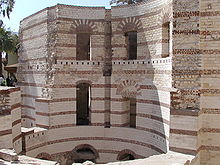Babylon Fortress
ⲡⲁⲃⲓⲗⲱⲛ | |
 Babylon Fortress | |
| Alternative name | ⲡⲁⲃⲓⲗⲱⲛ |
|---|---|
| Location | Cairo Governorate, Egypt |
| Region | Lower Egypt |
| Coordinates | 30°0′22″N 31°13′47″E / 30.00611°N 31.22972°E |
30°0′22″N 31°13′47″E / 30.00611°N 31.22972°E
Babylon Fortress (
It was at the boundary between Lower and Middle Egypt, where the river craft paid tolls when ascending or descending the Nile. Within the fortress's former enclosure are the present-day Coptic Museum, a convent, and several churches, including the Church of St. George and the Hanging Church.
Name
| ||||
| ẖrj ꜥḥꜣ (Kheriaha)[2][3] in hieroglyphs | ||||
|---|---|---|---|---|
| Era: Old Kingdom (2686–2181 BC) | ||||
| |||||
| pr ḥꜥpj n wn (Perhabinon)[4] in hieroglyphs | |||||
|---|---|---|---|---|---|
According to the 7th-century writer
Situation
Babylon lay northeast of Memphis, on the east bank of the Nile, and near the commencement of the Canal of the Pharaohs connecting the Nile to the Red Sea. It was the boundary town between Lower and Middle Egypt, where the river craft paid tolls when ascending or descending the Nile.[citation needed]
History
Some historical sources, such as John of Nikiu, report that a fortress named Babylon was first founded by
The fortress's origins are often associated with Trajan (r. 98–115), who created the Amnis Traianus, a reconstruction of the Red Sea canal that had fallen out of use. Trajan reportedly moved the mouth of the canal further south from its former location, to the site of what is now Old Cairo, where he also constructed a fortified harbor.[7] The construction of the present Babylon Fortress (whose remains are visible today) has been attributed by more recent archeological research to the reign of Diocletian (r. 285–305), who expanded the fortifications at the mouth of the canal around 300 AD.[10][11] The large new fortress, probably made necessary after the Crisis of the Third Century, provided a considerable defense for both the land and sea routes in the region. The canal passed between two massive round towers and ran through the middle of the fortress.[12] In later centuries, a wall was built between the two large towers to block the canal.[13]
The town was the seat of a
During the
During the
Gallery
References
Citations
- ^ "أسماء بعض البلاد المصرية بالقبطية - كتاب لغتنا القبطية المصرية". St-Takla.org. Retrieved 2024-02-26.
- ^ Gauthier, Henri (1927). Dictionnaire des Noms Géographiques Contenus dans les Textes Hiéroglyphiques Vol. 4. p. 203.
- ^ Wallis Budge, E. A. (1920). An Egyptian hieroglyphic dictionary: with an index of English words, king list and geological list with indexes, list of hieroglyphic characters, coptic and semitic alphabets, etc. Vol II. John Murray. p. 1030.
- ^ Gauthier (1925), p. 110
- ^ Sheehan 2010, p. 38.
- ^ Spiegelberg, Wilhelm (1904). Aegyptologische Randglossen zum Alten Testament. Schlesier & Schweikhardt. p. 39.
- ^ a b c Sheehan 2010, pp. 35–38.
- ^ Champollion, Jean-François (1814). L'Égypte sous les Pharaons (in French). Vol. II. Paris: De Bure. pp. 33–35.
- ^ Raymond 2000, pp. 2.
- ^ Sheehan 2010, pp. 35–38, 55, 59, 62–63.
- ^ Gabra et al. 2013, pp. 20–22.
- ^ Sheehan 2010, pp. 58–59.
- ^ Sheehan 2010, pp. 52, 63–64.
- ^ Michel Lequien, Oriens christianus in quatuor Patriarchatus digestus, Paris 1740, Vol. II, coll. 555–560
- ^ Klaas A. Worp, A Checklist of Bishops in Byzantine Egypt (A.D. 325 – c. 750), in Zeitschrift für Papyrologie und Epigraphik 100 (1994) 283–318
- ISBN 978-88-209-9070-1), p. 844
Bibliography
 This article incorporates text from a publication now in the public domain: Smith, William, ed. (1854–1857). "Ba'bylon 2.". Dictionary of Greek and Roman Geography. London: John Murray.
This article incorporates text from a publication now in the public domain: Smith, William, ed. (1854–1857). "Ba'bylon 2.". Dictionary of Greek and Roman Geography. London: John Murray.- Gabra, Gawdat; van Loon, Gertrud J.M.; Reif, Stefan; Swelim, Tarek (2013). Ludwig, Carolyn; Jackson, Morris (eds.). The History and Religious Heritage of Old Cairo: Its Fortress, Churches, Synagogue, and Mosque. American University in Cairo Press. ISBN 9789774167690.
- Raymond, André (2000) [1993]. Cairo. Translated by Wood, Willard. Harvard University Press. ISBN 978-0-674-00316-3.
- Sheehan, Peter (2010). Babylon of Egypt: The Archaeology of Old Cairo and the Origins of the City. Oxford University Press. ISBN 978-977-416-731-7.
Further reading
- Karelin, Dmitry A. The Reconstruction of the Diocletianic Fortress in Babylon of Egypt: Architectural Decorations and Details. Actual Problems of Theory and History of Art: Collection of articles. Vol. 9. Ed: A. V. Zakharova, S. V. Maltseva, E. Iu. Staniukovich-Denisova. Lomonosov Moscow State University / St. Petersburg: NP-Print, 2019, pp. 180–188. ISSN 2312-2129.





